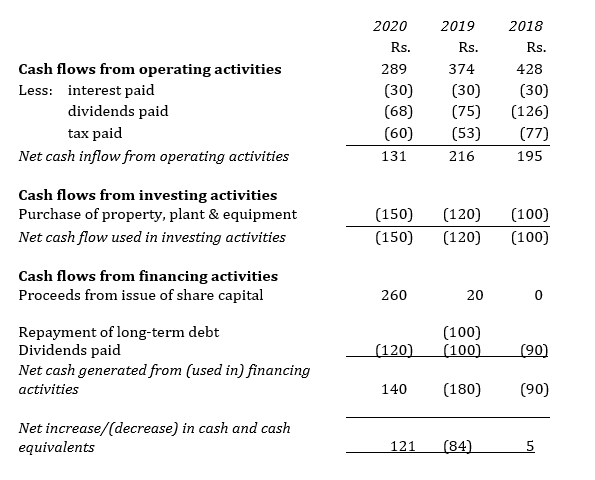Importance of time value of money
“Importance of time value of money” This is one of the crucial concepts in corporate finance. Even if you are a finance manager or student, you should have a good idea about the time value of money. Therefore, most of the time, the decision made in the real-world would depend on the time value of money.
This article begins by discussing earnings from various categories of income statements before looking at the cash flow statement. The chapter then revises the time value of money and uses the NPV techniques for annual and eternity. Finally, the section covers how many calculations can be performed in Microsoft Excel.
Cash flow vs. profit ( Earnings )
Most of the time, investors and lenders use different types of earnings and cash flow figures to make decisions. Earnings are referred to as “ profits “ made in the statement of profit and loss statement. Therefore, we can identify three types of earning calculation using the profit and loss statement.
1. Gross profit Gross profit shows the profits achieved by its primary business activity. This will not include other costs, such as administration costs. So this will be a good measure of underlying business performance to the investors and lenders. Therefore, the gross profit margin formula comes in handy in this situation.

2. Profit before interest and tax Common jargon used in corporate finance would be earnings before interest and tax “EBIT”. So we will take the profit made as to the total before any payments for taxed and interest. This will help the lenders make decisions such as credit enhancements, decisions on the required rate for debts etc. Moreover, lenders would consider interest cover ratio to see how many times the company can pay the interest. For instance, let’s assume the interest cover is five times, which means that the annual interest could be paid five times over from the profits.

3. Net profit This shows what is left for the ordinary shareholders. To make a decision, you can compare the past trends in the company for the net profit figure. The net profit margin shows how well the underlying business has performed and how well the business managed its administration costs.

Statement of Profit and Loss Statements

What does cash flow mean in business?
Many investors believe that cash flows are very important when assessing business performances. Therefore, cash flows are published in the cash flow statement in the company. These cash flow statements are governed by IAS 7.
Advantages of cash flow over profits “ earnings” of the company
There is a high possibility that the accounting policies can manipulate the earnings of a business. However, you can’t manipulate the cash flows of the company using the accounting policies. Therefore, it is wise to use cash flow analysis when you are making decisions to some extent.
Format of a cash flow statement

As above stated, there are three types of activities in the cash flow statement.
Net cash flow from operating activities, This shows the cash generated from the main business activity during the year. This value will almost equal to the EBIT, except for the deductions of non-cash activities such as depreciation.
Net cash flow from investing activities, We can classify all the cash inflows and outflows as a result of changes in non-current assets and financial assets.
Net cash flow from financing activities, This includes all the activities related to raising finances for company needs and the related cash outflows.
However, in the long term, when the finance manager is making the decisions, it is necessary to consider the time value of money. The time value of money is a basic outline of corporate finance.
Time value of money (TVM)
Time value of money (TVM) is an essential concept for investors; a dollar in hand today is worth more than a promised dollar. Assume that if someone owned your business, $1200 and the company would accept @1000 now that of $1200, which will be received in one year. Today the dollar can be used to invest and earn interest or capital gains. A dollar promised in the future is worth less than a dollar today due to inflation. Further, TVM can be broken into two areas. ( present value and future value )
What is the present value? This determines the value of the cash flows in today’s value.
PV = Cash flow x 1/ (1+ r) n
r is the discount rate n is the number of time periods between now and the date when the cash is received or paid.
PV = Cash flow x discount factor from the tables
Factors affecting discount value /What are the three elements of the time value of money?
Discount rates represent the time value of money, and three factors are affecting the time value of money.
- Interest rate – Opportunity cost of interest that could have been earned if cash is available.
- Risk – Higher the risk, higher the rate will be
- Liquidity preference – People would love to hold liquid assets like cash than receivables.
What is the future value of money?
The future value of money is the opposite of present value. That is the amount that an investor expects at some point in the future to give up today’s cash (or a cash receipt).
FV = PV x (1 + r)n
Where FV = Future value PV = present value r = discount rate n = the number of periods between now and the date that the cash is received or paid.
Annuity vs. perpetuity
What is a perpetuity?
This is a cash receipt or payment each year for an infinite period.
perpetuity formula
PV = C x 1/r
Where C = annual regular cash flow r = the appropriate discount rate
What is an annuity?
This is a cash receipt or payment each year for a finite time. So the difference between annuity and perpetuity depends on the period is known or not.
Annuity formula
PV = C x annuity factor
This is how to calculate the annuity factor.
PVA = C x (1/r x [1 – 1/(1+r) n )
Where C = annual regular cash flow r = the appropriate discount rate n= number of payments starting at time 1
Now, lets further discuss how to use excel for the above calculations.
How to calculate the present value of an annuity using excel?
The syntax of the formula for calculating the present value of an annuity is:
= PV (rate, nper, pmt, [fv], [type])
rate = the discount rate eg 0.05 or 5% nper = total number of payments made during the period pmt means the value of the regular payment (or receipt) fv – this is the fair value of a payment or receipt (if any) at the end of the annuity. type – you can use “o” when the payments are made at the end of a period . “1” can be used when the payments are made at the beginning of the period.
How to calculate the future value of an annuity using excel?
The syntax of the formula for calculating the future value of an annuity is:
= FV (rate, nper, pmt, [pv], [type])
Where FV = the future value of an annuity rate = the discount rate eg 0.05 or 5% nper = the number of payments pmt = the value of the payment [pv] = the present value – that is the value of any payments made at the current time in addition to the regular sums that will be payable under the annuity. The term can be omitted if there are no such payments. [type] – as with the PV the type can take two values. 0 means the payments occur at the end of each period, 1 means they occur at the beginning.


